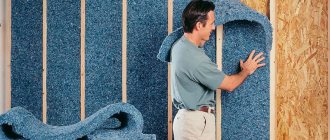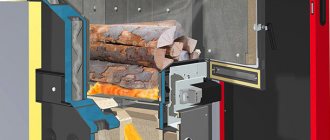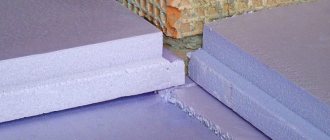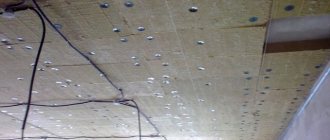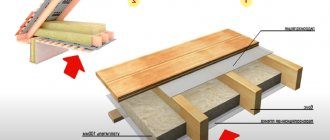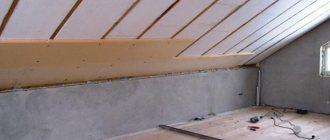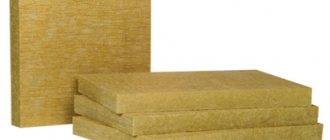Before you insulate a wooden house from the outside, you need to correctly select all the materials. A wooden building has its own characteristics. The first thing to remember is why wood continues to be so popular. There are several reasons for this:
- good thermal performance;
- ensuring a comfortable microclimate in the building;
- environmental friendliness;
- safety;
- ability to pass air (wood “breathes”).
The insulation of a wooden house from the outside should be chosen so that all materials do not reduce the beneficial properties of wood. But sometimes this can be difficult to do. To choose a good insulating material, you will need to spend your time and study basic information on the issue.
No. 1. Is it necessary to insulate a wooden house?
It would probably be redundant to list all the advantages of wooden houses. They once and for all captivated the people with their environmental friendliness, beauty, warmth and durability . Wood has a lower thermal conductivity coefficient than brick or even aerated concrete. If the climate in the region is warm and mild, and the house is used for vacation or temporary residence, then you can get by with a minimum set of measures. It will be enough to insulate the seams with inter-crown insulation and protect the wood with special means.
In regions with cold winters, a wooden house without insulation will require more serious heating. Over time, the wood, under the influence of external unfavorable factors, will begin to rot, dry out and crack. The seams are also deformed, too many cold bridges are formed due to shrinkage, rodents make holes, and the microclimate in the room is greatly deteriorated. If the house is located in a region with a harsh climate and is used for permanent residence, sooner or later it will have to be insulated . The best time for this is a couple of years after construction, when the walls have settled.
Insulating a wooden house provides many advantages:
- the service life of the house will increase;
- it will become warmer inside the house;
- the wood will be protected from all unfavorable factors: temperature changes, frost, humidity, pests, condensation, mold development;
- Heating costs will be reduced and the house will become warmer.
The main thing is not to turn the building into a nondescript and non-breathable box. Therefore, care when choosing insulation for a wooden house and during its installation will not hurt.
How is heat lost?
Before insulating a log house from the outside, you need to understand whether there is any point in thermal insulation at all.
Often, insulation for the walls of an old or new house is used to prevent heat loss. That is, the heat from the house goes outside. This disrupts the comfortable microclimate, the log house freezes, and also requires more heating costs. Wouldn't it be better to eliminate these heat losses?
The question of whether it is necessary to install insulation can be answered as follows. If the log house was originally built correctly, in compliance with the technology, with high-quality caulking, and also from material of sufficient size, then additional insulation may not be required. The design retains heat perfectly.
But when the house is old, cracks and gaps have formed, or a small log was initially chosen, then insulating a log house from the outside will become mandatory and also a necessary measure.
Most often, heat is lost due to mistakes made and defects during construction. These are left through gaps between materials, as well as the formation of gaps and cracks as a result of shrinkage.
Start checking for heat leaks from the ceiling. It is through it that about 70% of the heat escapes. Also check the condition of the floor, door and window openings. Inspect the current condition of the caulk.
You have to think about insulating the outside of an old house after a while. But if this is a new house, then you should ask questions about thermal insulation at the construction stage.
No. 2. What kind of insulation should be used for a wooden house?
Let us emphasize once again that wood is a breathable material ; it can absorb and release moisture, regulating the microclimate of the room. That is why it is somehow especially easy to breathe in wooden houses. If we cover a tree with a vapor-proof material, we will not only lose the main advantage of the log house, but also harm it, because disruption of air exchange can lead to the accumulation of moisture in the tree, its swelling, and the appearance of mold. Where will the moisture come from? Yes, at least from inside the house. To avoid such problems, the insulation must be vapor-permeable. In addition, damp walls cannot be insulated; it is important to use waterproofing, and it is highly advisable to use the ventilated façade technique.
The following requirements are put forward for the insulation of wooden walls:
- vapor permeability;
- low thermal conductivity, the lower it is, the better the material retains heat;
- non-flammability. Everyone knows that wood is easily flammable and burns, so when paired with it it is better to use materials that are as resistant to fire as possible;
- low weight. The lighter the material, the easier it is to install. If the insulation is too heavy, you will need a more durable frame, which means time and extra costs.
It is clear that not every existing insulation material is suitable for a wooden house. However, many people deliberately make the wrong choice. The following materials are usually used for thermal insulation:
- all mineral wools (stone wool, slag wool, glass wool and ecowool), they have high vapor permeability;
- Solid polymer insulation (expanded polystyrene and polystyrene) is not prohibited, but you are deliberately blocking the breathing of the house . Yes, these are easy-to-install and practical insulation materials, but you will have to organize a very serious ventilation system, and this is a considerable expense during installation and operation. It is advisable to use such materials only for insulating a concrete base and foundation ;
- loose insulation materials (vermiculite crushed stone, expanded clay gravel, perlite crushed stone) allow air and moisture to pass through well, are not afraid of high temperatures, are not interesting for rodents, but they have a low thermal insulation coefficient, so they are suitable only for warm regions, but they have not gained much popularity there either ;
- interventional insulation is used when it is necessary to preserve the original appearance of the house.
Instead of insulation, wooden lining is also used to protect the house from precipitation and winds. When treated with antiseptics and fire retardants, the material actually slightly extends the life of the house. It turns out that wooden walls are externally lined with wooden panels. Wouldn't it be better to just treat the existing walls and seal the seams? But finishing with wooden lining is a good option when using a layer of insulation. Externally, you will get the same wooden house, only warmer.
It is recommended to insulate a wooden house from the outside. Internal insulation takes up a lot of useful space and negatively affects the microclimate, but it is also allowed provided there is a continuous vapor barrier layer inside the house.
Vapor barrier and waterproofing
To give a detailed and accurate answer to the question: “How to properly insulate a wooden house from the outside?”, you need to know and understand that vapor barrier is installed only on the warm air side, and waterproofing on the cold air side. And also that the external and internal material can take the form of films and membranes. For wooden buildings, it is recommended to choose the latter type of structure. Since the film practically does not allow air to pass through, but the membrane “breathes”. Read more in the article: “Vapor barrier of walls of a wooden house.”
Layout of vapor barrier layers
PS Before you insulate an old wooden house from the outside with your own hands, you need to check the condition of the walls, ceilings and roof. Clean from dirt and dust. If necessary, strengthen the building structure. Carry out proper treatment against mold and mildew. The measures outlined will significantly extend the service life of wooden buildings.
No. 3. Interventional insulation for a wooden house
The most gentle way of insulation is the use of inter-crown insulation. The process itself is called caulking. Ideally, a wooden house should be caulked first a couple of months after its construction, and then after 6-8 months. The gaps between logs or beams are filled with tow, jute, and sometimes even moss is used.
They begin to caulk the walls from the very bottom of the house. Each crown is first caulked around the perimeter, outside, and then inside. Only after this do they move on to the next crown, and so on until each crack is filled from the outside and inside. After caulking, the house may become 5-8 cm higher, but then it will shrink slightly, pressing down on the insulation and forming windproof walls.
Tow or jute is pushed into the cracks using a hammer, chisel, caulking shovel and rubber mallet. The process will be labor-intensive and long. If you are not confident in your own abilities, it is better to entrust the work to specialists.
A more modern caulking method involves the use of acrylic “warm joint” sealants. They allow air to pass through and protect cracks well from moisture and temperature changes. They are a little easier to work with. Some people prefer to cover caulk seams that are not entirely aesthetically pleasing with a twisted cord, at least from the inside.
In any case, the wood itself will have to be protected with antiseptics, fire retardants or varnishes.
No. 4. Mineral wool for insulation
The mineral wool group is most suitable for insulating a wooden house. However, each material from this group has its own distinctive properties, which are worth considering separately.
Stone (basalt) wool
Stone wool is made from rocks, most often basalt is used, hence the name. Various binders and additives are added to the composition, and the result is a rolled or tile material coated with foil, kraft paper or fiberglass and with the following advantages :
- fire resistance. Stone wool tolerates temperatures up to 6000C, which is not surprising considering the production process and the raw materials used;
- low thermal conductivity (0.038-0.047 W/m*C);
- high vapor permeability;
- hygroscopicity;
- resistance to microorganisms;
- light weight and correct shape make installation easier;
- the material does not shrink due to its density and rigidity;
- basalt fibers do not cause skin irritation.
One of the disadvantages is the fragility of the material. Stone wool is more expensive than other mineral wools.
Glass wool
It is produced from rocks with a high silicon content, but more often from glass waste. The raw material is melted, limestone, dolomite, borax and other components are added to it. The finished insulation consists of fairly long fibers, which explains its rigidity, elasticity and strength, but these fibers are glass, which means they are thorny. Available in rolls and slabs, it can be coated with foil or reinforcing fiberglass.
pros:
- excellent vapor permeability;
- low thermal conductivity coefficient (0.029-0.046 W/m*C);
- high strength with low density;
- fire resistance, withstands up to 4500C;
- resistance to temperature changes and aggressive substances.
The main disadvantage is the fragility and thorniness of glass fibers, which easily penetrate the skin and respiratory tract. All work is carried out only with comprehensive personal protective equipment. When wet, glass wool loses a significant part of its thermal insulation properties, so you will need high-quality waterproofing. It is cheaper than basalt wool, but more expensive than slag wool.
Slag wool
For production, waste from blast furnace production is used. Since they are supplied to manufacturers almost free of charge, the insulation is inexpensive. Mats and slabs have a slight rigidity and are sometimes coated with foil on one side.
pros:
- low cost;
- resistance to high temperatures, but in this indicator slag wool is inferior to stone wool, as it can withstand heating up to 250-3000C;
- excellent vapor permeability;
- good sound insulation properties;
- slag wool is not interesting for rodents;
- the slight rigidity of mats and rolls allows finishing curved surfaces.
Minuses:
- hygroscopicity;
- sensitivity to temperature changes;
- worst thermal conductivity in class (0.46-0.48 W/m*C);
- when wet, sulfuric acid can be released, which has a negative effect on wood and metal;
- The slag fibers are quite sharp, so it is impossible to work without protective equipment.
Of the entire class, slag wool is the least suitable for insulating a wooden house, but is actively used due to its low cost.
Ecowool
The material is produced from waste from the paper industry. 80% of its composition is cellulose, the rest is additives that make the material more durable. Fire retardants and antiseptics are added to ecowool.
pros:
- low thermal conductivity coefficient (0.032-0.041 W/m*C);
- environmental friendliness and vapor permeability;
- Although ecowool can absorb moisture, its thermal insulation properties remain almost unchanged;
- ability to absorb noise and vibrations;
- resistance to rodents and insects.
The main disadvantage is installation. Ecowool is a loose material that is sold in bags. Before application, it is loosened with a mixer, and then applied to the wall manually or mechanically. The denser the layer, the better, since a layer that is not dense enough shrinks quickly, and here you are not far from cold bridges. The manual installation method is time-consuming, and there are no quality guarantees. Installation with a pneumatic installation is expensive, as you will have to hire specialists.
Procedure for insulating with mineral wool (slabs and rolls)
Installing slab or roll insulation is not so difficult. Experts recommend starting insulation when the house has already shrunk, i.e. about two years after its construction. To work, you will need a tape measure and level, a drill, a hacksaw, a stapler, wood sealant, a membrane for waterproofing and the insulation itself. The calculation is not difficult to do, just calculate the perimeter of each side of the house, add up the indicators and add 7-10% of the margin. If a double layer is required, then the result is multiplied by 2. A 50*50 mm timber will be used for the sheathing, and 100*40 or 100*50 mm for the double layer.
The work order is as follows:
- preparation of the base. Clean the walls from mold, dust and dirt, if there are voids in the crowns, re-seal them with sealant, and then seal the seams with sealant. It is also better to repair cracks in wood. The wood must be dry, so it is better to work in the summer after a long period without precipitation;
- padding. If the wood quickly absorbs the primer, apply a second coat;
- frame installation. The beams are fastened in increments of 10 mm less than the width of the insulation. The first beam is mounted near the corner of the house, 5-10 cm from it. Fasten the sheathing with self-tapping screws;
- installation of insulation boards in the resulting recesses, it is desirable that there are no gaps. The slabs should lie tightly, but to ensure that, disc-shaped dowels are used. If a second layer of insulation is needed, it is laid so that the joints between the slabs of the first layer are closed;
- installation of the protective membrane using a stapler and tape. Each subsequent strip should overlap the previous one by 10-15 cm; it is better to glue the joint with tape;
- installation of the counter-lattice with self-tapping screws, then wooden lining or other facing material is attached to it. This is a ventilated façade technique.
There are other ways . Mineral wool can be mounted on U-shaped metal hangers. They are placed along the entire length; slots are made in the slabs, with the help of which they are put on hangers. Next comes a layer of membrane, and the hangers also serve for installing the finishing.
Another way is to glue mineral wool slabs to the wall with additional fixation with dowels. Next, cement mortar is applied for leveling and reinforced with fiberglass mesh. All that remains is to prime the wall, apply a layer of plaster and paint (not acrylic compounds). This is a “wet” facade method , which is not particularly suitable for wooden houses , because plaster is a static shell, and wood is mobile. Cracks may occur.
Procedure for insulating ecowool
If you decide to install ecowool manually, you will have to follow this procedure:
- preparing the base according to the scheme described above;
- installation of timber sheathing in increments of 50-60 cm;
- covering the sheathing with moisture-resistant OSB boards to a height of 80-100 cm from the ground;
- unpacking ecowool, fluffing it in a container using a drill with a mixer attachment. The goal is to eliminate all lumps;
- The prepared ecowool is used to fill the opening between the wall of the house and the cladding, carefully compacted, paying attention to the corners and crevices;
- when the opening is almost filled, attach more sheathing for the next 80-100 cm and repeat the steps;
- Finally, the sheathing is primed and cladding begins.
It will be easier if you use a special installation . The sheathing pitch is 1-1.2 m; water is added to the wool before spraying to form an adhesive mass. They spray the cotton wool in a dense, even layer, let it dry, then clean off the excess, install the membrane and begin facing work.
No. 5. Polymer insulation
I wouldn’t dare recommend this group of materials for insulating a wooden house. Polymer materials do not breathe, which means that all the advantages of wooden walls go down the drain. When using such insulation, you will need a serious ventilation system. It is justified to use them when insulating concrete slabs and stone plinths.
Expanded polystyrene
It is popularly called polystyrene foam. The material consists of a mass of balls that are interconnected to form small cavities.
pros:
- low weight and ease of processing;
- good thermal conductivity (0.036-0.051 W/m*C)
- low price;
- durability;
- soundproofing.
The disadvantages are more significant:
- flammability;
- vapor tightness;
- Rodents love to make burrows in polystyrene foam;
- Water can accumulate in the cavities between the foam balls. The water absorption rate by volume for 24 hours is 2%, for 30 days – 4%. Not so much, but accumulated moisture during freezing can destroy the structure of the insulation.
Too much work will have to be done to protect the material from fire, rodents and moisture, and to provide ventilation in the house, so it is better not to insulate wooden walls in this way - the low price of polystyrene foam is not justified by other expenses.
Extruded polystyrene foam
This is a more advanced insulation material, a material related to foam plastic, but the production method is completely different, hence the difference in properties.
pros:
- low thermal conductivity (0.028-0.034 W/m*C). If the house is located beyond the Arctic Circle, then this is the best solution;
- light weight;
- ease of installation;
- moisture resistance;
- quite high strength.
The serious disadvantages are vapor resistance, flammability and high price.
PVC foam
The insulation is made on the basis of polyvinyl chloride (PVC). The result is a lightweight cellular material with an impressive range of advantages:
- high strength, higher than that of extruded polystyrene foam;
- low thermal conductivity coefficient (0.035-0.07 W/m*C)
- combustion resistance;
- good vapor permeability, the highest in this class of materials;
- biostability.
Everything would be fine if not for the price. The material is very expensive, and when burned, although it is prone to self-extinguishing, it releases hydrogen chloride, which, when combined with water, produces hydrochloric acid.
Conclusion
You must decide on your own what is the best way to insulate the outside walls of your home. However, when choosing heat-insulating materials, you should definitely consider the following factors:
- resistance of the material to moisture, since the facade is exposed to atmospheric influences;
- non-flammability - choose a material containing fire retardants that prevent the spread of fire;
- ease of installation is an important quality that allows you to do the work yourself;
- high vapor permeability;
- degree of heat capacity;
- the price indicator is also not the least important.
The thermal insulation properties of polyurethane foam are equal to the properties of a brick wall 1 meter thick
All materials have different characteristics, which does not allow us to give a clear answer which one is better. The choice will depend on the characteristics of the building, as well as the quality and thickness of the walls. Each of the listed insulation materials has the right to exist and is capable of producing an effect when used correctly.
No. 6. Polyurethane foam for insulating a wooden house
This type of insulation has recently been used more and more often, and it is the sprayed version of it. There is also an option in the form of slabs. Sprayed polyurethane foam requires the use of special equipment, but it fills all the cracks well and creates a seamless coating.
pros:
- low thermal conductivity coefficient (0.019 W/m*C);
- resistance to temperature changes, durability;
- resistance to fire, rodents, rotting;
- light weight;
- resistance to water.
The main disadvantage is vapor permeability; according to this indicator, the material is 50 times worse than mineral wool. In addition, spraying will require special equipment, which must be operated by a professional, and this affects the price. Polyurethane foam is afraid of sunlight. Frankly speaking, it is not very suitable for wooden houses, but if the goal is not to preserve the ability of the structure to breathe, then this insulation can be used.
Cost of finishing materials
All work on insulation and cladding of a wooden house requires large financial investments. The cost depends on:
- Scope of work performed.
- Conditions of external walls.
- Type of insulation.
- Quality of waterproofing membranes.
- Type of decorative material.
- Additional fasteners.
- The work can be done independently or by a professional team.
Therefore, before starting to insulate the facade, they calculate the approximate cost with a margin and compare it with the available budget. By making calculations in advance, you can be sure that the work will not stop halfway due to lack of funds.
No. 7. Calculation of insulation thickness
To calculate what layer of insulation will be needed , you can use special calculators or the services of specialists. This takes into account the presence of windows, the required temperature in the house and other parameters. You can do the calculation yourself:
- We determine the value of the normalized heat transfer resistance of the walls of the house for your region. The easiest way is to look at the table. Let’s say the house is located somewhere in the Moscow region, then the required resistance will be 3.28 m2*C/W. This indicator should be achieved due to the resistance to heat transfer of walls and insulation;
- We determine the heat transfer resistance coefficient of the existing walls of the house. Let's say the house is made of pine timber, for which the resistance is 0.18 W/m*C;
- the wall thickness is 20 cm, which means the heat transfer resistance will be 0.2 / 0.18 W/m*C – 1.11 m2*C/W;
- difference from the standard value (3.28-1.11) = 2.17 m2*C/W;
- In order to achieve the required resistance value, insulation must be used. We choose stone wool with a thermal conductivity coefficient of 0.04 W/m*C. We get 2.17 m2*C/W*0.04 W/m*C = 0.0868 m, or 8.7 cm. You can use 10 cm thick cotton wool.
Properly selected and installed insulation will make a wooden house more durable and comfortable, and the external walls can be sheathed with a block house so as not to lose its unique appearance.
The article was written for the site.
Tags:Wood beams, Wall insulation
Further measures to protect residential buildings made of chopped logs
Once a wooden house has been insulated and finished, you should not leave it unattended for a long time. At least once a year, the casing is checked for integrity and dirt is cleaned. If defects appear on the decorative surface due to mechanical stress, then you should check whether the insulation and waterproofing are damaged.
In principle, further activities will depend on the chosen decorative material. If it was a wooden block house, then it must be coated with protective compounds. For siding, there are no special requirements.
Plaster requires more complex maintenance. Cracks need to be repaired in a timely manner. If the color has lost its attractiveness and brightness, the surface is re-painted.

